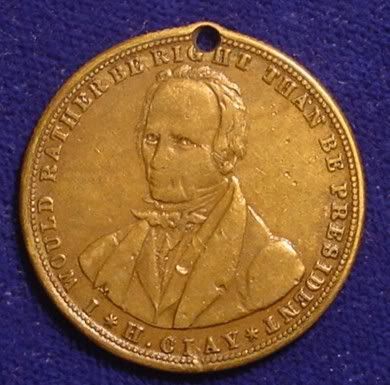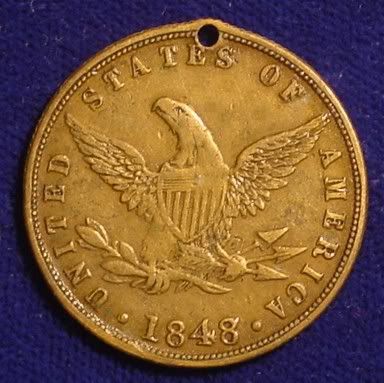A recent acquisition, a Zachary Taylor presidential campaign medalet


Here is my latest acquisition. It is an 1848 Zachary Taylor presidential campaign medalet. It is listed in DeWitt / Sullivan as ZT 1848-17. The obverse shows a nice portrait of the general. The reverse, which is crudely executed, features a Ms. Liberty with a sheep and a spinning wheel. Around the edge in virtually unreadable letters is the slogan, “Liberty and union now and forever one and inseparable.” It’s interesting to note that concerns about the break-up of the union over the slavery issue were part of the 1848 presidential campaign.
Zachary Taylor is one of those obscure presidents who has disappeared into the mists of history. He was the last Whig Party presidential candidate to win the presidency. He came to national prominence when he led the American forces who ultimately won the Mexican War in 1848. Taylor did his job so well that President James K. Polk relived him of command and replaced him with Winfield Scott. Polk was concerned that if Taylor won all the glory he would use his hero status to ride into the White House, which is exactly what happened. Oddly, Taylor wasn’t particularly politically ambitious.
Zachary Taylor was perhaps the most apolitical man ever to hold the office. He freely admitted before the Whigs nominated him that he had never voted in a presidential election. In fact, there is a reasonable possibility that he didn’t vote in his own presidential election! He aligned himself with no party although when pressed he said that he was a Whig, but not a strong Whig. But given the dearth of candidates available to the Whigs, and his status as a war hero, he was a logical choice.
The big issue during Taylor’s administration was slavery. Although Taylor owned slaves, he strongly refused to support the Southern position, which called for the extension of slavery into more states and territories. He indicated that he would veto any bills that expanded slave territory. One book that I read recently suggested that had he lived Taylor might have prevented the Civil War. I found that assertion far-fetched. But Taylor does deserve credit for holding the line on that highly divisive issue when most other politicians at the time were playing the slavery issue to their best perceived advantage.
Taylor’s death has been controversial. On July 4, 1850 he sat in the hot sun for two hours during an event at the site of the Washington Monument, which was under construction. After that he took a stroll in the sun. Upon returning to the White House the hungry and thirsty President wolfed down copious quantities of cherries and iced milk. He developed a case of severe cramps that doctors diagnosed as cholera morbus. Such conditions were common in Washington, DC where sanitation was poor and diseases were common in the summer months. Taylor’s conditions worsened, in part because his doctors bled him and give him huge doses of medicine. On July 9, the president died.
Years later there was speculation that someone poisoned Taylor because of his views on slavery. If that had been true he would have been the first president to have been assassinated. The curiosity grew so intense that his body was exhumed and examined. Doctors found that his death had been from natural causes.
Taylor’s successor was Millard Fillmore, who gained some fame from joke makers because he had previously been so historically obscure. Fillmore’s greatest accomplishment, if you could call that, was to get the Compromise of 1850 passed. It should be noted that Zachary Taylor had vowed to veto the provisions in that bill if it had been passed during his presidency. The worst part of the Compromise of 1850 was the fugitive slave law which further split the North and South apart.


You don’t have to pay a fortune for Zachary Taylor medalets. The trouble is finding them. This is the most common piece, ZT 1848-21. It took me a while to find one of these, but when I up graded it this one, I actually lost money on the first one. Zachary Taylor is clearly not on the front burner for many collectors! You will note the eagle on the reverse of this piece bears a strong resemblance to the one that appears on U.S. gold coinage of the period. Medalet designers often used this device to draw attention to their work.


As a footnote here is another 1848 medalet that was issed for Henny Clay. Clay had already lost in three presidential elections, but that did not stop him from wanting to run again as the Whig Party candidate. This might be called "the sour grapes" medalet. It reads, "I'd rather be right than be president." Clay had uttered that phrase ten years before during a Congressional debate.
Retired dealer and avid collector of U.S. type coins, 19th century presidential campaign medalets and selected medals. In recent years I have been working on a set of British coins - at least one coin from each king or queen who issued pieces that are collectible. I am also collecting at least one coin for each Roman emperor from Julius Caesar to ... ?
0
Comments
Didn't wanna get me no trade
Never want to be like papa
Working for the boss every night and day
--"Happy", by the Rolling Stones (1972)
<< <i>Taylor’s death has been controversial. On July 4, 1850 he sat in the hot sun for two hours during an event at the site of the Washington Monument, which was under construction. After that he took a stroll in the sun. Upon returning to the White House the hungry and thirsty President wolfed down copious quantities of cherries and iced milk. He developed a case of severe cramps that doctors diagnosed as cholera morbus. Such conditions were common in Washington, DC where sanitation was poor and diseases were common in the summer months. Taylor’s conditions worsened, in part because his doctors bled him and give him huge doses of medicine. On July 9, the president died. >>
So was it cholera morbus or the doctors that killed him?
<< <i>So was it cholera morbus or the doctors that killed him? >>
Probably a bit of both, but if I had to make a bet I'd vote for the doctors. They gave him opium, calomet and quinine. They also raised blisters and bled him. Toward the end of this ordeal he reported became extremely depressed and stated that he would never recover. If I were throwing up and had severe diarrhea and a feaver and was getting "medial help" like that, I think I would have come to the same conclusion.
-Randy Newman
<< <i>I have a campaign medal from 1848, but it's of Taylor's opponent, Gen. Lewis Cass. I inherited it from my grandfather. It's quite scarce and sort of desirable by political collectors, but it's unfortunately in very worn condition. >>
You are very fortunate. Louis Cass and James K. Polk medalets are among the scarcest of all the 19th century candidates. Back in the late 1800s the quality of one's political token collection was judged by the quantity and quality of Cass and Polk pieces the collector had. I have only one Lewis Cass piece. I don'y have a photo of that piece, but will post one if there interest.
Stefanie
.
CoinsAreFun Toned Silver Eagle Proof Album
.
Gallery Mint Museum, Ron Landis& Joe Rust, The beginnings of the Golden Dollar
.
More CoinsAreFun Pictorials NGC FOR SALE
I really like this one
Stefanie
.
CoinsAreFun Toned Silver Eagle Proof Album
.
Gallery Mint Museum, Ron Landis& Joe Rust, The beginnings of the Golden Dollar
.
More CoinsAreFun Pictorials NGC FOR SALE
Check my ebay BIN or Make Offers!!
<< <i>This is the forum at it's finest. Thank you! >>
I agree. Great history lesson. Thanks.
<< <i>I have a campaign medal from 1848, but it's of Taylor's opponent, Gen. Lewis Cass. I inherited it from my grandfather. It's quite scarce and sort of desirable by political collectors, but it's unfortunately in very worn condition. >>
This is probably the Lewis Cass piece that you have. It is the most common of the Lewis Cass varieties, but it is still quite scarce.
The reason for the rarity of the Lewis Cass political medalets dates back to the election of 1840. That year the Whig Party was running William Henry Harrison for president. Their strategy was to run a campaign based on images not issues. They issued very large numbers of Harrison pieces. The Democrats took exception to it.
In 1844 the Democratic Party platform stated, and I'm paraphrasing, that they would not issue trinkets and other gimmick items that insulted the intelligence of the people. That year Democratic supporters issued very few medalets for James K. Polk, but they still won the election. In 1848 they did the same thing with Cass, but they lost, in part because of that. After that the Democrats seemed to learn their lesson, and they issued significant numbers of items for their candidates.
Here's one of the many varieties that the Whigs issued for Harrison in 1840. If you have been to a number of coin shows, you may well have seen a piece that looks like this. Most, but not all, had a portrait of Harrison on the obverse and a log cabin on the reverse.